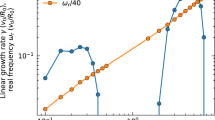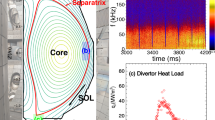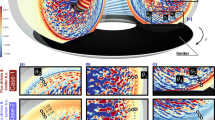Abstract
Alpha particles with energies on the order of megaelectronvolts will be the main source of plasma heating in future magnetic confinement fusion reactors. Instead of heating fuel ions, most of the energy of alpha particles is transferred to electrons in the plasma. Furthermore, alpha particles can also excite Alfvénic instabilities, which were previously considered to be detrimental to the performance of the fusion device. Here we report improved thermal ion confinement in the presence of megaelectronvolts ions and strong fast ion-driven Alfvénic instabilities in recent experiments on the Joint European Torus. Detailed transport analysis of these experiments reveals turbulence suppression through a complex multi-scale mechanism that generates large-scale zonal flows. This holds promise for more economical operation of fusion reactors with dominant alpha particle heating and ultimately cheaper fusion electricity.
This is a preview of subscription content, access via your institution
Access options
Access Nature and 54 other Nature Portfolio journals
Get Nature+, our best-value online-access subscription
$29.99 / 30 days
cancel any time
Subscribe to this journal
Receive 12 print issues and online access
$209.00 per year
only $17.42 per issue
Buy this article
- Purchase on Springer Link
- Instant access to full article PDF
Prices may be subject to local taxes which are calculated during checkout




Similar content being viewed by others
Data availability
The JET experimental data are stored in the Processed Pulse File system, which is a centralized data storage and retrieval system for data derived from raw measurements within the JET torus, and from other sources such as simulation programs. These data are fully available for EUROfusion Consortium members and can be accessed by non-members under request to EUROfusion. Numerical data that support the outcome of this study are available from the corresponding authors upon reasonable request.
Code availability
The research codes cited in the paper require prior detailed knowledge of the implemented physics models and are under continuous development. The corresponding authors can be contacted for any further information.
References
Ongena, J., Koch, R., Wolf, R. & Zohm, H. Magnetic-confinement fusion. Nat. Phys. 12, 398–410 (2016).
Litaudon, X. et al. Overview of the JET results in support to ITER. Nucl. Fusion 57, 102001 (2017).
Shimada, M. et al. Chapter 1: overview and summary. Nucl. Fusion 47, S1–S17 (2007).
Doyle, E. J. et al. Chapter 2: plasma confinement and transport. Nucl. Fusion 47, S18–S127 (2007).
Romanelli, F. Ion temperature-gradient-driven modes and anomalous ion transport in tokamaks. Phys. Fluids B 1, 1018–1025 (1989).
Citrin, J. et al. Nonlinear stabilization of tokamak microturbulence by fast ions. Phys. Rev. Lett. 111, 155001 (2013).
Garcia, J. et al. Key impact of finite-beta and fast ions in core and edge tokamak regions for the transition to advanced scenarios. Nucl. Fusion 55, 053007 (2015).
Di Siena, A., Görler, T., Doerk, H., Poli, E. & Bilato, R. Fast-ion stabilization of tokamak plasma turbulence. Nucl. Fusion 58, 054002 (2018).
Di Siena, A. et al. Electromagnetic turbulence suppression by energetic particle driven modes. Nucl. Fusion 59, 124001 (2019).
Fasoli, A. et al. Chapter 5: physics of energetic ions. Nucl. Fusion 47, S264–S284 (2007).
Gorelenkov, N., Pinches, S. D. & Toi, K. Energetic particle physics in fusion research in preparation for burning plasma experiments. Nucl. Fusion 54, 125001 (2014).
Todo, Y. Introduction to the interaction between energetic particles and Alfvén eigenmodes in toroidal plasmas. Rev. Mod. Plasma Phys. 3, 1 (2019).
Heidbrink, W. W. & White, R. B. Mechanisms of energetic-particle transport in magnetically confined plasmas. Phys. Plasmas 27, 030901 (2020).
Zarzoso, D. et al. Impact of energetic-particle-driven geodesic acoustic modes on turbulence. Phys. Rev. Lett. 110, 125002 (2013).
Cheng, C. Z. & Chance, M. S. Low-n shear Alfvén spectra in axisymmetric toroidal plasmas. Phys. Fluids 29, 3695–3701 (1986).
Fu, G. Y. & Van Dam, J. W. Excitation of the toroidicity-induced shear Alfvén eigenmode by fusion alpha particles in an ignited tokamak. Phys. Fluids B 1, 1949–1952 (1989).
Pinches, S. D. et al. Energetic ions in ITER plasmas. Phys. Plasmas 22, 021807 (2015).
Diamond, P. H., Itoh, S. I., Itoh, K. & Hahm, T. S. Zonal flows in plasmas – a review. Plasma Phys. Control. Fusion 47, R35–R161 (2005).
Heimpel, M., Aurnou, J. & Wicht, J. Simulation of equatorial and high-latitude jets on Jupiter in a deep convection model. Nature 438, 193–196 (2005).
Todo, Y., Berk, H. L. & Breizman, B. N. Nonlinear magnetohydrodynamic effects on Alfvén eigenmode evolution and zonal flow generation. Nucl. Fusion 50, 084016 (2010).
Qiu, Z., Chen, L. & Zonca, F. Effects of energetic particles on zonal flow generation by toroidal Alfvén eigenmode. Phys. Plasmas 23, 090702 (2016).
Chen, L. & Zonca, F. Physics of Alfvén waves and energetic particles in burning plasmas. Rev. Mod. Phys. 88, 015008 (2016).
Breizman, B. N. & Sharapov, S. E. Major minority: energetic particles in fusion plasmas. Plasma Phys. Control. Fusion 53, 054001 (2011).
Heidbrink, W. W. Basic physics of Alfvén instabilities driven by energetic particles in toroidally confined plasmas. Phys. Plasmas 15, 055501 (2008).
Kazakov, Y. O. et al. Efficient generation of energetic ions in multi-ion plasmas by radio-frequency heating. Nat. Phys. 13, 973–978 (2017).
Ongena, J. et al. Synergetic heating of D-NBI ions in the vicinity of the mode conversion layer in H–D plasmas in JET with the ITER like wall. EPJ Web Conf. 157, 02006 (2017).
Nocente, M. et al. Generation and observation of fast deuterium ions and fusion-born alpha particles in JET D–3He plasmas with the 3-ion radio-frequency heating scenario. Nucl. Fusion 60, 124006 (2020).
Kazakov, Y. O. et al. Physics and applications of three-ion ICRF scenarios for fusion research. Phys. Plasmas 28, 020501 (2021).
Hawryluk, R. J. in Physics of Plasmas Close to Thermonuclear Conditions Vol. 1 (eds Coppi B. et al.) 19–46 (Pergamon Press, 1981).
Ongena, J., Voitsekhovitch, I., Evrard, M. & McCune, D. Numerical transport codes. Fusion Sci. Technol. 61, 180–189 (2012).
Artaud, J. F. et al. The CRONOS suite of codes for integrated tokamak modelling. Nucl. Fusion 50, 043001 (2010).
Garcia, J., Görler, T. & Jenko, F. Isotope and fast ions turbulence suppression effects: consequences for high-β ITER plasmas. Phys. Plasmas 25, 055902 (2018).
Campbell, D. J. et al. Stabilization of sawteeth with additional heating in the JET tokamak. Phys. Rev. Lett. 60, 2148–2151 (1988).
Graves, J. P. et al. Experimental verification of sawtooth control by energetic particles in ion cyclotron resonance heated JET tokamak plasmas. Nucl. Fusion 50, 052002 (2010).
Gates, D. A., Gorelenkov, N. N. & White, R. B. Ion heating by fast-particle-induced Alfvén turbulence. Phys. Rev. Lett. 87, 205003 (2001).
Jenko, F., Dorland, W., Kotschenreuther, M. & Rogers, B. N. Electron temperature gradient driven turbulence. Phys. Plasmas 7, 1904–1910 (2000).
Citrin, J. et al. Electromagnetic stabilization of tokamak microturbulence in a high-β regime. Plasma Phys. Control. Fusion 57, 014032 (2014).
Görler, T. et al. On the validation of gyrokinetic L-mode simulations. Fusion Sci. Technol. 69, 537–545 (2016).
Mazzi, S. et al. Impact of fast ions on a trapped-electron-mode dominated plasma in a JT-60U hybrid scenario. Nucl. Fusion 60, 046026 (2020).
Gorelenkov, N. N. et al. Anomalous electron transport due to multiple high frequency beam ion driven Alfvén eigenmodes. Nucl. Fusion 50, 084012 (2010).
Crocker, N. A. et al. Three-wave interactions between fast-ion modes in the national spherical torus experiment. Phys. Rev. Lett. 97, 045002 (2006).
Biglari, H., Diamond, P. H. & Terry, P. W. Influence of sheared poloidal rotation on edge turbulence. Phys. Fluids B 2, 1–4 (1990).
Stix, T. H. Heating of toroidal plasmas by neutral injection. Plasma Phys. 14, 367–384 (1972).
Brizard, A. J. & Hahm, T. S. Foundations of nonlinear gyrokinetic theory. Rev. Mod. Phys. 79, 421–468 (2007).
Merz, F. Gyrokinetic Simulation of Multimode Plasma Turbulence. PhD thesis, Univ. Münster (2008).
Görler, T. Multiscale Effects in Plasma Microturbulence. PhD thesis, Univ. Ulm (2009).
Pankin, A., McCune, D., Andre, R., Bateman, G. & Kritz, A. The tokamak Monte Carlo fast ion module NUBEAM in the National Transport Code Collaboration library. Comp. Phys. Commun. 159, 157–184 (2004).
Brambilla, M. Numerical simulation of ion cyclotron waves in tokamak plasmas. Plasma Phys. Control. Fusion 41, 1–34 (1999).
Grierson, B. A. et al. Orchestrating TRANSP simulations for interpretative and predictive tokamak modeling with OMFIT. Fusion Sci. Technol. 74, 101–115 (2018).
Acknowledgements
We thank M. Baruzzo and F. Nave for the preparation and execution of JET experiments discussed in this paper; E. de la Luna for support in detailing the experimental diagnostics of JET; A. Ho for assistance in processing the experimental data; T. Görler for providing essential advice to ensure the correct numerical setup for the GENE modelling reported in this paper; Y. Camenen, X. Garbet and A. Bierwage for fruitful discussions about the gyrokinetic analyses; G. Giruzzi for valuable suggestions on the article strategy. The simulations were performed on the IRENE Joliot-Curie HPC system, in the framework of the PRACE projects IONFAST and AFIETC, led by J. Garcia, and on the CINECA Marconi HPC within the project GENE4EP, led by D. Zarzoso. This work has been carried out within the framework of the EUROfusion Consortium and has received funding from the Euratom research and training programme 2014-2018 and 2019-2020 under grant agreement no. 633053. The views and opinions express herein do not necessarily reflect those of the European Commission. Part of the work by Ye. O. Kazakov and J.Ongena was also carried out in the framework of projects done for the ITER Scientist Fellow Network (ISFN).
Author information
Authors and Affiliations
Consortia
Contributions
The reported JET experiments were designed and coordinated by Ye. O. Kazakov, M. Nocente, J. Garcia and J. Ongena; S. Mazzi, J. Garcia, D. Zarzoso and S. Benkadda performed gyrokinetic modelling and subsequent analysis, including additional simulations requested by the reviewers. Input data for gyrokinetic modelling were provided by Ž. Štancar, G. Szepesi and M. Dreval. Ž. Štancar performed TRANSP modelling. J. Garcia performed power balance analysis and CRONOS simulations. M. Dreval provided analysis of the TAE radial location and the correlation reflectometer data. The bispectral analyses were performed by S. Mazzi and D. Zarzoso, J. Eriksson and A. Sahlberg provided neutron measurements data from TOFOR. The original manuscript was written by S. Mazzi, J. Garcia, D. Zarzoso, Ye. O. Kazakov and J. Ongena with feedback from all the authors. Major revisions of this manuscript were undertaken by Ye. O. Kazakov, J. Ongena, J. Garcia and S. Mazzi.
Corresponding authors
Ethics declarations
Competing interests
The authors declare no competing interests.
Peer review
Peer review information
Nature Physics thanks Neal Crocker, Chris Holland and the other, anonymous, reviewer(s) for their contribution to the peer review of this work.
Additional information
Publisher’s note Springer Nature remains neutral with regard to jurisdictional claims in published maps and institutional affiliations.
Supplementary information
Supplementary information
Supplementary Figs. 1–7 with accompanying text.
Rights and permissions
About this article
Cite this article
Mazzi, S., Garcia, J., Zarzoso, D. et al. Enhanced performance in fusion plasmas through turbulence suppression by megaelectronvolt ions. Nat. Phys. 18, 776–782 (2022). https://doi.org/10.1038/s41567-022-01626-8
Received:
Accepted:
Published:
Issue Date:
DOI: https://doi.org/10.1038/s41567-022-01626-8
This article is cited by
-
Tailoring tokamak error fields to control plasma instabilities and transport
Nature Communications (2024)
-
Periodic orbits in chaotic systems simulated at low precision
Scientific Reports (2023)
-
Gyrokinetic theory of toroidal Alfvén eigenmode saturation via nonlinear wave–wave coupling
Reviews of Modern Plasma Physics (2023)



